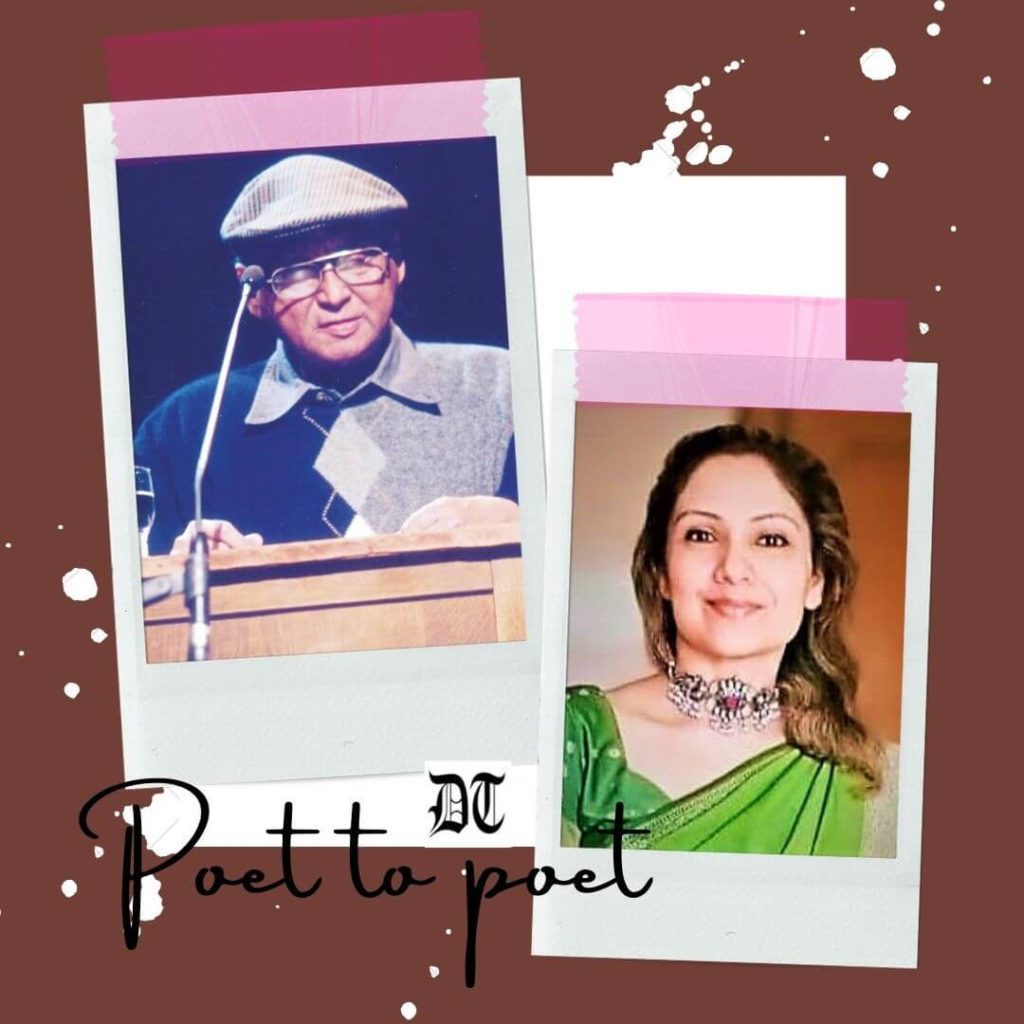Jayanta Mahapatra, an Odia poet, and former physics teacher significantly influenced Indian literature with his poignant poetry on themes of destitution, poverty, and the human condition, blending scientific precision with poetic sensitivity, elucidates Arindam.[1].
[1] A brief version of this paper was presented at a webinar organised by The Fertile Brain (TFB), on September 7, 2023.
Jayanta Mahapatra (Oct 22, 1928, to August 27, 2023), a renowned Odiya poet and former physics teacher, left an indelible impact on Indian literature with his evocative poetry that frequently explored themes of destitution, poverty, and the human condition. His unique ability to combine scientific precision with poetic sensitivity and an infantile innocence in his exploration of life’s complexities earned him a unique place in the literary world. This paper will examine the influences that influenced Jayanta Mahapatra’s poetic sensibilities and how he channelled his experiences into a body of work that continues to resonate with contemporary readers.
He was born on 22 October 1928 in Cuttack, Odisha, and his early existence was marked by financial difficulties. He earned a bachelor’s degree in physics from Ravenshaw College and then pursued a career as a professor. During these years, his poetic journey started to take shape. His poems, which were profoundly influenced by the harsh realities of poverty and destitution he witnessed around him, became an outlet for him to express his thoughts, emotions, and reflections.
Childlike Innocence
Childlike innocence is one of the most remarkable aspects of Mahapatra’s poetry. His poems conveyed a sense of awe and inquiry, as if he viewed the world through the eyes of a child, despite his penchant for tackling gloomy topics. This purity gave his work a unique perspective, allowing readers to investigate intricate themes from a fresh and unencumbered perspective. It also made his poetry accessible to a broad audience, transcending age, and background barriers.
In the Introduction of From Re-reading Jayanta Mahapatra (2022), Black Eagle Publications, Prof Nandini Sahu, wrote: “My personal relationship with Sir has evolved over the years from that of a student/researcher to that of a daughter (even he says I am his granddaughter!) to that of almost his mother. For the past few years, I have treated him as if he were my child; I dote on him, reprimand him when he neglects his health or fails to eat on time, and I protect and adore him…. He merely has faith. Before Covid, I recall being scheduled to share the dais with him at a Lit Fest. Sir was famished, but the majority of his admirers were occupied taking photos with him for social media posting. I asked him to eat before the meeting, but the elaborate Chinese cuisine on the menu was inappropriate for a man of his age. I requested that the event organisers provide fruit salads or straightforward dal rice. However, as anticipated, everyone was too occupied. I departed my session, proceeded to the home of one of my teachers, and obtained a piece of Podopitha (a confection made of fermented rice-black gramme flour and grated coconut). When I arrived, the session had concluded, but he was still seated and famished. When he saw the Podopitha, he became emotional. He told me while consuming the cake that this was his preferred dish.”
Poverty and Destitution in the Poetry of Mahapatra
The theme of adversity and destitution recurred frequently in the poetry of Mahapatra. He depicted the marginalised and disadvantaged in evocative and often unsettling detail, spotlighting their struggles and resiliency. The socioeconomic disparities that afflicted society were harshly reflected in his poems. Through his poetry, he cast light on the brutal realities encountered by the poor, giving them a voice in the literary world.
The poems of Mahapatra frequently conveyed a profound sense of empathy and compassion for those living on the margins of society. His ability to empathise with their plight and express it through his poetry rendered his work not only moving but also socially pertinent. He used his writing to bring attention to issues that were extremely important to him.
Here are a few lines from an Introduction by Prof Smita Agarwal, in Marginalized: Indian Poetry in English, Rodopi/ Brill, 2014. She states, “Jayanta Mahapatra is no longer writing in English. He has embraced his mother-tongue Oriya to express his feelings. That he is emotionally sensitive, as well as, a quintessential romantic poet, I can testify, at a conference in Navi Mumbai in 2008, while addressing a school hall packed with children who were gazing at him with adoration, Mahapatra broke down and sobbed at the mike while describing the numbing effects of poverty in rural Orissa.”
In his recent article, The Master of Imagery and Empathy Passes Away, Ksom Blog, Dr Satya Narayan Mishra, opined, “Social reality and depicting its and depicting its interiors is one of Jayanta Mahapatra’s central themes. He bemoaned the poets who wrote about metropolitan India while ignoring the plight of rural India. In the poem Dusk, he penned:
As in film, freedom's stock is limited. a lack of want, social justice Positioned above the writhing heartland And in the noises of nude soles on the ground The sloped hamlet route Hunger is in the air. A fact that will anger the heavens.
“He was truly concerned about the harsh reality of acute poverty and social injustice in rural India. In this aspect, he had a close parallel with the filmmaker Mrinal Sen who made Akaler Sandhane depicting how rural life has not changed much from the time when the Bengal famine struck.”
Later, Dr Mishra adds, “His poems, Indian Summer and Hope are considered classics in modern English literature. Taste for Tomorrow, Hunger, and Relationship won him enormous accolades. The oppressive claustrophobic, with its depth, disease and decay, beggars, and poverty, pervades his work. Two important qualities of his work, however, stand out. One is his innate humanitarianism, his empathy for the underdog, violence, oppression, poverty among others and the other is his metaphorical imagination, which is highly developed and extremely fertile. Here is a sample of his unique use of imagery:
At Puri, the Crows The One Wide street Lolls out like a giant tongue As a priest passes by.
“Relationship, a major work of his, uses the Konark Sun Temple as a focus for the exploration of the Orissan past.
Sorrow or Losses Re-assembled
I quote Nabina Das, a prominent poet herself, who wrote in Scroll.in (Rivers, nostalgia, and solitude: Poet Jayanta Mahapatra’s essential art at 94, May 20, 2023): “The twin rivers of Mahanadi and Kathajodi that embrace poet Jayanta Mahapatra’s hometown Cuttack constitute a motif that he lives by every day. In the dusty Odisha towns of Cuttack and Puri, and the bye-lanes of memory and activity, the poet proliferates with his crows, bamboo groves of shedding leaves, cries of hawkers, and life moving along the ghats of grace and repose.
A man does not mean anything
But the place
Sitting on the riverbank throwing pebbles
Into the muddy current,
A man becomes the place.
— From ‘A Rain of Rites’.“The arc of the rivers that entwine Cuttack, its delta, and the bustling human life of thousand years is the purveyor of cohesion and amalgamation of senses for Mahapatra. The sorrow or losses are re-assembled into his own thirst for a seamless world of justice:
At times, as I watch,
it seems as though my country’s body
floats down somewhere on the river.
Left alone, I grow into
a half-disembodied bamboo,
its lower part sunk
into itself on the bank.
Here, old widows and dying men
cherish their freedom,
bowing time after time in obstinate prayers.
While children scream
with this desire for freedom
to transform the world
without even laying hands on it.
— ‘From Freedom’.”Mahapatra and the Freedom Movement
Dr Mishra states, “In 1942, at the age of fourteen, Jayanta enrolled at Ravenshaw College to pursue science and physics.
“The college’s history is synonymous with the history of modern Odisha. It was founded in 1868. It pulsated with its carefully planned out tennis courts and placid and passionate cannons positioned before the portico. This was the year that World War II reached its climax, and on August 9, 1942, Gandhi issued the Quit India call. Slowly and inexorably, Jayanta was drawn into the movement.
“In a commemorative volume titled Ravenshawvian (2009), he writes, “I recall the mute murmurs of the verdant lawns and the smiles of my professors, which never failed to reflect the harsh light of knowledge. My heart resembled in part the air raid shelter, the dark and dreary subterranean chamber; a place where the footfall of my youth shuddered at its edge and then took green wings and flew away into the sky.”
An Innovative Anglophile Poet
Dr Mishra deliberates, “In fact, Jayanta, who began his career as a physics teacher, rose steadily to become one of the most innovative, purposeful, and Anglophile poets of contemporary India. Along with Ramanujam, Parthasarathy, and Ezekiel, he established the basis for Indian English poetry.
“His debut novel, Close the Sky Ten by Ten, was published in 1971. Since then, a constant stream of poems, short stories, and essays has culminated in the publication of 16 volumes in English.
“He also founded and edited the journal, Chandrabhaga; the mere determination and dedication required to carve out a literary career from his uncompromising origins is astounding.
“Intriguingly, stones play a central role in his poetry. In his 1981 book titled, Relationship, he writes:
My existence is founded on stones. Which transport my footfall from one day to the next? Down to infinity and beyond When nightfall arrives, the stones grow closer.”
At the Crossroads of Science and Poetry
As a physics instructor, Mahapatra imbued his poetry with scientific precision, juxtaposing the rigour of science with the emotional world of art. His poems were intellectually stimulating and emotionally resonant due to this unique combination. His scientific background enabled him to explore the complexities of human existence and the natural world with a keen eye, thereby enhancing the meaning of his verses.
Dr Mishra mentions, “He was once asked about the relationship between his background in science and opting to write poetry. Jayanta replied: “I suppose that the study of Physics taught me a certain discipline to write concisely, not to use unnecessary words in a poem.”
In our web journal, DifferentTruths.com, (Jayanta Mahapatra: A Life in Poetry, 1928-2023, August 27, 2023), Urna Bose, who interviewed him, wrote, “A small, niggling doubt has often crossed my mind. Is it best to keep our heroes at a distance? Worship the writers and poets we admire, from far, far away. Safely seated as they are, on that gilded pedestal, carefully constructed for them, in our heads and our hearts. And what happens if we interact with them on a personal level someday? See them for the human beings that they are. Would those diamond-encrusted images splinter and crack a bit? And how do we cushion our worshippers’ expectations?

“I have been a diehard fan of Jayanta Mahapatra – I endearingly call him Jayanta-da – ever since I was in class VIII. And having to interview someone who is my Poetry God, filled me with much hesitation, many a nervous twitch. But all my trepidation melted away under the resplendent, sunshiny goodness of Jayanta-da.
“Someone who can teach us many lessons about humility, kindness, and what it means to be a colossally gorgeous human being. As I interacted with Jayanta-da, the real man behind the iconic work and covetous awards, I realised he deserves every bit of the pedestal. Along with the throne, the crown, the velvet cloak, the embellished sceptre, and all that we endow our poetry heroes with.”
Mahapatra’s poetry is often intimate and thoughtful. He delves into his recollections and experiences, as well as wider historical and cultural topics. His poems are generally marked by loss and desire, yet they often include moments of beauty and optimism.
Anupama Raju, in her tribute to Mahapatra, wrote in Scroll.in: “Death is an early preoccupation and recurring theme, even in Jayanta’s younger days. In “The False Start” (1980), we have a poem, “Ash” in which we find: “The substance that stirs in my palm/could well be a dead man”. The death of his father, mother, wife, and daughter over the years, has irrevocably played a role in this preoccupation. In “Measuring Death”, we are left with a haunting image. He says,
“Death is a handcart you push, through a dayful of moonlight, of sadness you can’t trust.”
His Will and Death
I paraphrase a report in The New Indian Express. It stated that Padma Shri awardee Mahapatra defied his Christian faith and chose cremation over burial in his will. The funeral was conducted following the poet’s wishes, said Cuttack Mayor Subhas Singh, who also emphasised that Mahapatra’s passing was a significant loss not just for Odisha or India, but for the entire global literary community.
In his will, Mahapatra also made a generous gesture to J. Sarojini, who had faithfully served his family for 35 years. Although Mahapatra’s wife and son had passed away before him, his daughter-in-law and grandchildren resided in Singapore. Mahapatra also requested that his letters, typescripts, and unfinished manuscripts be burned after his demise.
In his later years, Mahapatra was only accompanied by his extensive collection of books and J. Sarojini, his devoted caretaker for over five decades. Sarojini joined the Mahapatra household when she was just 18, quickly becoming an integral part of the family. Mahapatra affectionately referred to her as his daughter and even had a house built for her behind his own.
When Sarojini passed away in December of the previous year, her son J. Issac, also known as Jeju, and daughter-in-law J. Sandhya assumed the responsibility of caring for Mahapatra until his last moments.
Dev Prakash Das, a close family friend, explained, “For a long time, Sarojini took care of the family, and she continued to do so even after his wife’s passing. He grew lonely after her demise since his son and daughter-in-law were living in Singapore. Later, Sarojini began to suffer from knee pain, affecting her mobility, but she continued to look after him. Eventually, her son Jeju married Sandhya, and the couple began taking care of him as Sarojini’s health deteriorated.”
Was Mahapatra Lonely?
Finally, whether the poet felt lonely is a question of interpretation. He was, without a doubt, a complicated and sensitive person who was severely impacted by the death of his loved ones.Several quotations from Mahapatra indicate that he indeed was lonely. He once said that “poets can never be lonely” because they “inherit the world; they draw the world into them.” He did, however, mention that “the past is a constant presence, while the future only peeks around the corner.” This shows that he was often troubled by recollections of his loved ones who had died.
Did Mahapatra experience loneliness? Each person must answer it for himself/herself. There is little question, however, that he was an individual who was greatly impacted by loss and sought consolation in his work.
I close with a poem by Jayanta Mahapatra, published in DifferentTruths.com:
A Missing Person In the darkened room a woman cannot find her reflection in the mirror waiting as usual at the edge of sleep In her hands she holds the oil lamp whose drunken yellow flames know where her lonely body hides.
Photos from the archives of Different Truths





 By
By
 By
By

 By
By